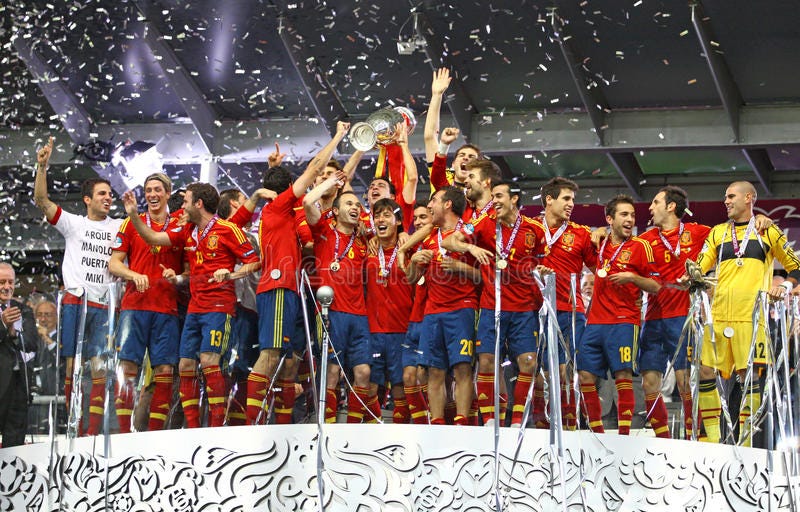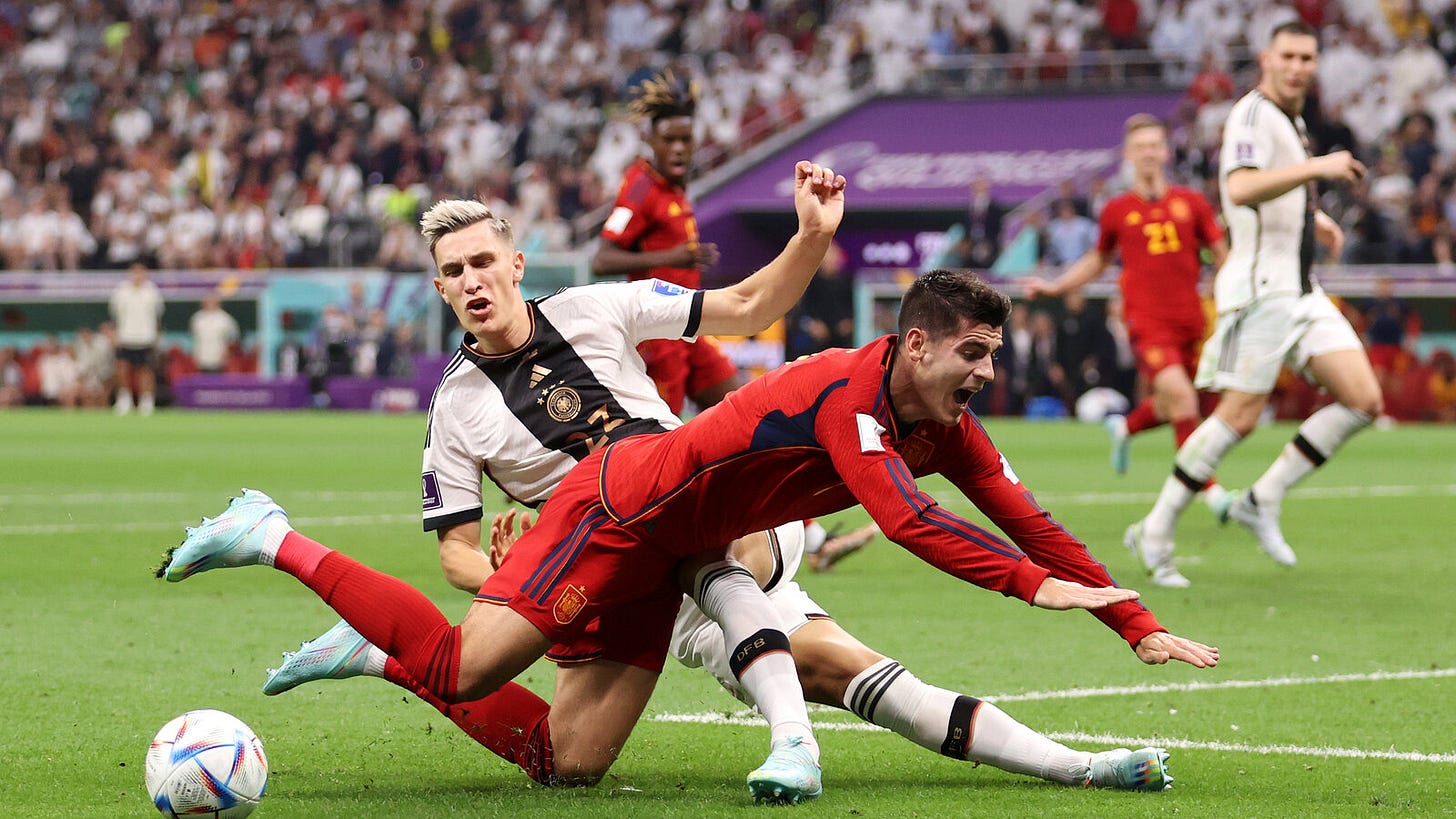Striking Conundrum for Spain
Spain are out of the World Cup. What can they learn from a very similar team from a decade ago?
The year is 2012.
It’s the European Championships, and shorn of the injured David Villa, who led his team in goals in qualifying and in helping his country to the Euro 2008 and 2010 World Cup crowns, Spanish manager Vicente Del Bosque decides to start the tournament without a striker altogether. Instead, he plays with six midfielders, looking to dominate possession with the tiki-taka style that has made Pep Guardiola’s Barcelona side the undisputed best team on the planet, and play keep-away with any opposition teams.
Throughout their Euro 2012 campaign, the first ten names on Spain’s team sheet were ever-present. The legendary Iker Casillas in goals, a defensive line made up of Álvaro Arbeloa, Gerard Piqué, Sergio Ramos, and Jordi Alba. Sergio Busquets anchoring a midfield with the iconic, Xavi Hernández, Xabi Alonso, Andrés Iniesta, and David Silva playing ahead of him. These ten men started every single game. The only question ever in Vicente del Bosque's mind was who their focal point would be up top.
Del Bosque’s experimentation with a striker-less formation had been a frustrating and underwhelming experience over the past year. Spain were wholly lacking in directness and penetration when they got into dangerous positions high up the pitch, and instead of taking advantage of their mountains of possession, they spent far too log pinging the ball around the midfield like they were playing a real-life game of pinball. I can’t think of why, but that sounds like a familiar problem for the Spaniards…
Spain had been drawn into a tough group for the Euros, alongside Croatia, Italy and the Republic of Ireland. Italy were up first, and it became a perfect microcosm of every issue with this Spanish side. Del Bosque had started the tournament with Cesc Fabregas playing as a true false nine, dropping deep into midfield to link up play between the deep lying Busquets and Alonso, while also switching positions regularly with David Silva on the right. The game ended 1 – 1, but the formation was relatively unsuccessful. Their equalising goal had come from a superb bit of individual brilliance, Silva getting the ball with his back to goal and slipping a beautiful pass in for Fabregas to run onto and finish, but this was a rare piece of penetration. All too frequently, Silva and Fabregas ended up occupying the same space.
As a result of this, Fabregas was dropped for Spain’s next game against the Republic of Ireland, with Fernando Torres starting up front, scoring two good goals in a decent all-round performance, the Chelsea striker was particularly impressive with his pressing high up the pitch, constantly forcing the Irish defenders into misplaced passes. Torres deservedly started the next game against Croatia but found this encounter much more difficult. While Ireland had defended with a wide back-line and a compact midfield, attempting (unsuccessfully, sadly for a young me watching at home) to stop Spanish attacks at the source and break forward quickly on the attack, the Croatians sat in a mid-block blocking Spain from making many forays into the final third. Torres had three attempts, all from difficult angles and he was then replaced after an hour by Jesus Navas.
Therefore, against France in the quarter-final, it was back to Fabregas as a False 9. And here, for the first time, Spain appeared to function well without a permanent centre-forward. There were differences to the False 9 that had been deployed against Italy though, as Fabregas had stopped dropping deep. If Cesc did choose to drop into a position, mostly it would have been wide to the right of the pitch so that David Silva could use the movement in positions to break through the defensive line onto Fabregas’ through balls.
The striker-less system seemed to be confounding other teams now, and Spain had finally figured out a way to make it work. That’s what made Del Bosque’s decision to start with Alvaro Negredo against Portugal in the semi-final particularly strange. Portugal pushed high up the pitch and offered space in behind, but Negredo rarely made the right runs. His link-up play was disappointing, he had only one shot, and his main contribution was winning fouls from Portugal’s defenders. Fabregas replaced him after only 54 minutes. When he came on, it was as if they had all forgotten what made the team so successful against France, with Fabregas again coming deep to collect the ball. It was a lucky escape in the end for the World Champions, going through to the final on penalties.
Del Bosque, like many practitioners of Cruyff’s Total Football philosophy throughout the years, had overthought his selection for the semi-final. He did not make the same mistake the next time. Spain became the first side to win the European Championships with the same starting XI in both their opening game and the final, but while the names were identical, Fabregas’ role was completely different. While against France he had played like a False 9 tasked with swapping positions with his right-winger, in the Final he played less like a False 9 and more like a Midfielder used in a centre-forward’s role.
In Inverting The Pyramid, Jonathan Wilson says of Fabregas’ role:
“He was there at the front of the attack for the ball to be bounced off, to provide more angles for the midfield, playing almost as a Target-Man, just receiving balls on the ground rather than in the air.”
While Fabregas was midfielder by trade, his role in the final was simply that of a true centre-forward, making runs off the shoulder of defenders, being used as a pivot point for the other attackers to create angles off of. Fabregas was the key player in that final, at the peak of Spanish football dominance.
Fast-forward to 2022.
It is incredible how much this year’s Spanish World Cup team is like that team from a decade ago. Excellent technical talent throughout the entire midfield, an inconsistent striker on the bench who feeds off of confidence but gets it obliterated when the smallest thing doesn’t go his way, an almost complete inability to score goals against teams that deploy a mid-block, and Jordi Alba and Sergio Busquets are still around too! Spain, once again, were an anomaly at a major competition, but there was actually a severe difference between the two sides. Their Head Coach.
Only England (12) have scored more goals than Spain, who went into the Morocco game having netted 10 times in the group stage, but despite those numbers, Luis Enrique's team had virtually no goal threat against well-organised opponents. Their 7 – 0 drubbing of (my poor boys) Costa Rica in their opening game of the tournament has skewed the picture a bit, as when it came to their games against Germany, Japan and Morocco, they never really looked threatening at all.
Like the team of 2012, Spain played for the most part with a False 9, this time in the form Real Madrid winger, Marco Asensio, once again starting a player out of position in order to play in their favoured shape. Personally, I think this was a masterstroke by Luis Enrique. If the current Real Madrid number 11 stood out for anything in his early days at the club, it was for his finishing ability. He is not an explosive player over short distances, however, once he starts running with the ball under control, it is very difficult to take it away from him. Also, Asensio possesses a formidable technical quality, which is due to his excellent coordination structure that allows him to perform high quality technical actions. Spain’s issues in attack were not because of Asensio’s quality as a player, but rather how he was deployed.
Take the German game as an example. Germany played a high, compact mid-block but weren’t especially aggressive, giving the Spanish defensive line all the space in the world to pass the ball around, but leaving them with nowhere to pass into. Spain held a dominant 64% of possession, but despite that, their field tilt (which measures possession specifically in the final third) was only 53%.
Spain seriously lacked a cutting edge in the final third. This team is perfectly able to play around and through you. They can drop Asensio in as their False 9 in order to create numerical advantages and open up the ball into space, but they’re far from devastating once they make that space, since Asensio dropping deep robs them of an extra man pushing into the box. It’s no coincidence that once Morata, an out-and-out striker who wasn’t going to be tasked with the job of a False 9, came on for him, Spain managed to find the net through his penetrative running off the last defender. With Morata’s inconsistency though, it’s hard to commit to starting him regularly, especially on such a major stage.
With Morocco, Enrique started with Marco Asensio ahead of Morata, but once again the Real Madrid forward offered little threat as he was tasked again with dropping deep to overload the midfield rather than using the abilities that he is truly gifted with. Morata, when he came on just after the hour mark, was given that freedom to play as a centre-forward. He made a few more penetrating runs than Asensio, but his severe inconsistency when it comes to finishing and occasional lack of awareness meant he gave Spain nothing to write home about from the opportunities created by and for him.
Enrique seemed to have only two plans:
A: Keep possession of the ball, A magical Tiki-Taka fairy comes along and puts the opposition to sleep for a few seconds, goal
B: If that doesn’t work, bring on Morata and hope he’s in a good mood
The second one actually worked a few times! Unfortunately for Plan A, magical fairies were banned from all stadiums in Qatar after Spain’s game against Costa Rica.
Luis Enrique won’t be looking back much on the games played in this tournament. While writing this piece, news emerged that he will be stepping down as manager of the Spanish Men’s National Football team. Subsequently it was revealed that their next head coach will be the current (now former) Spain U21 manager Luis de la Fuente. I think this was actually the right decision. Enrique is an incredible manager and an astute tactical mind, don’t get me wrong. But during this World Cup, Spain stuck way too rigidly to a plan that clearly was not working. Rather than try to evolve and adapt, Enrique stuck with the same single idea that he believed would work out in the end. It never did, and now Spain are looking ahead to their Euro 2024 qualification campaign under new management.
What Spain need to do going forward is stick with Marco Asensio centrally, but allow him to play direct like Cesc Fabregas did in the Euro 2012 final. Spain need a whole lot more directness honestly, and would benefit hugely from playing someone like Ansu Fati, a vertical player who can add directness while his team is in possession, on a consistent basis, especially ahead of a consistently disappointing Ferran Torres.
The Tiki-Taka style of football is beautiful to watch, but as Casey Evans noted in a recent piece:
“… it is not so dominant against every team that it is worth abandoning everything else to sustain it. Especially in a knockout tournament where a single moment matters even more.”.
Vicente Del Bosque was an idealogue like Luis Enrique, but when that idea was not working, he wasn’t afraid to make some small changes so that the team as a whole could benefit. Luis de la Fuente now has the job of making sure those little changes are made so that this high-potential young Spanish side can thrive in their next campaign.




